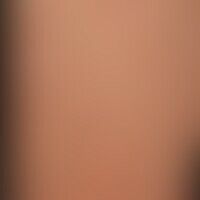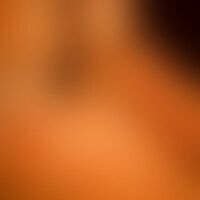Image diagnoses for "Leg/Foot"
395 results with 1158 images
Results forLeg/Foot

Pretibial myxedema E03.8
Myxoedema pretiabiales: circumscribed, blurred, yellowish-reddish, firm, hardly compressible, otherwise symptomless swellings; here a partial symptom of Graves' disease; typical is the orange peel-like surface of the swelling.

Dyshidrotic dermatitis L30.8
eczema, dyshidrotic: detailed picture with inensively itching intraepithelial vesicles, circumscribed scaling and brownish felts (healed efflorescences). no signs of atopy. no contact allergy.

Collagenom storiformes D23.L
Knotig polypoides collagenoma, (solitary, nodular non-pigmented lesion).
Dermatoscopy: Radially arranged, tortuous and partially branched vessels with white structureless area and white plaques.
DD: Knotig basalioma, pilomatrixoma, sebaceous gland hyperplasia.

Lichen simplex chronicus L28.0
Lichen simplex chronicus: approx. 18x12cm large, itchy plaque with rough surface left lower leg of a 25-year-old female patient. in the loosened marginal area the primary papular structure of the lesion is visible. DD: Lichen amyloidosus.

Acrodermatitis chronica atrophicans L90.4
Acrodermatitis chronica atrophicans: Livid red erythema in atrophic skin, shimmering vein network.

Porokeratosis superficialis disseminata actinica Q82.8
Porokeratosis superficialis disseminata actinica, overview: Chronically active, multiple, disseminated, partly confluent, erythematous, anular plaques localized at the extensor sides with sharply defined, hyperkeratotic border wall.

Collagenosis reactive perforating L87.1
Collagenosis, reactive perforating, chronically dynamic (continuous neoplasms since 1 year), 0.1-0.5 cm large, slightly itchy, rough, red, rough papules, which ulcerate centrally during growth.

Scar atrophic L90.5
Scars atrophic: large-area older scar after burns; no restriction of knee mobility.

Contact dermatitis toxic L24.-
Contact dermatitis, toxic: Hyperkeratosis on inflammatory changed skin on the right wrist dorsally and on the back of the right hand of a 46-year-old patient.

Keratoma sulcatum L08.8
Keratoma sulcatum: Disseminated, as if punched out, smallest corneal layer defects; distinct hyperhidrosis of the feet with strong foetor.

Erysipelas A46
erysipelas.extensive, sharply defined, painful redness and plaque formation in the area of the lower leg. entry portal: macerated tinea pedum. secondary findings include fever and chills, lymphangitis and lymphadenitis

Granulomatosis disciformis chronica et progressiva L92.1
Granulomatosis disciformis chronica et progressiva: solitary, non-infiltrated, polycyclically limited, brown, symptomless, slow-growing spot.

Hypertrophic Lichen planus L43.81
Lichen planus verrucosus: extensive, blurred, chronically stationary, coarse, brownish-red, rough, wart-like plaques with severe itching. scarring after healing. numerous scratch excoriations.

Primary cutaneous diffuse large cell b-cell lymphoma leg type C83.3
Primary cutaneous diffuse large cell B-cell lymphoma leg type: red nodules occurringwithin a few months in an otherwise healthy 54-year-old woman.

Circumscribed scleroderma L94.0
Circumscribed scleroderma (linear type): linear scleroderma (running in the Blaschko lines) which developed within a half-year period. no symptoms.

Unilateral naevoid telangiectasia syndrome I78.8








